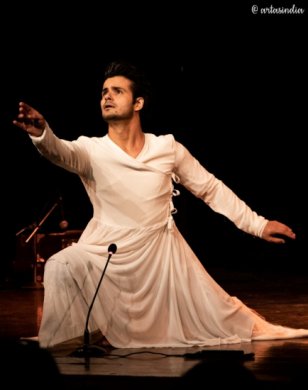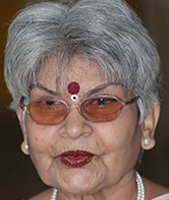
|   |

|   |
The Parabola of Dance: Performance and process - Manjari Sinha e-mail: manjari@sinha.com November 19, 2022 Aditi Mangaldas Dance Company: the Drishtikon Foundation is known for presenting something different from a routine performance of Kathak, which is the base of their technique, training, and choreographies. This time it was the 'Parabola of Dance: Performance and Process', presented recently at the Stein auditorium of Habitat Centre, New Delhi. Curated by Aditi Mangaldas this was an evening of performance and dialogues by three established dancers namely Gaurav Bhatti, Rashmi Uppal, and Gauri Diwakar. Each one of them presented one of their dance choreographies and then talked about the trajectory of its creative process sharing the actual journey from conception to the final realization of the choreographic work they presented this evening. There was a sizable audience, wondering what the 'Parabola of Dance' meant. Aditi explained, "If you take a focal point and make circle around it, then it could be repetitive as your ideas keep meandering around the circumference. In contrast, the parabolic path represents ideas that are constantly evolving, making your journey take you to unexpected destinations. There is a constant change. I think that is what, as an artiste, I feel very excited about. I have invited three amazing dancers and choreographers for an evening of performance and dialogue. They will first perform a solo from their own choreographic repertoire, and then share the process they undertook to develop the work. They would talk about the choices they made to realize the choreography. I hope to develop this into a platform of learning and sharing and look forward to inviting other dance practitioners in the future, making it into an annual event." Aditi added, "I think it is important for the audiences to know what is the process that goes into the final work that they see on a proscenium stage." Aditi Mangaldas also showed the trailer of her latest contemporary work 'Forbidden' based on Kathak, which would be premiered at the Tata Theatre, NCPA Mumbai, on the 4th of December. This was followed by the screening of another short video of the making of 'Forbidden', which is about female sexual desire. She questions about why there is so much anxiety about female sexuality. "Why are they so scared of female sexual desire? World over, whether it's a conservative or liberal society, women are judged, controlled, and eventually punished to have the courage to own their own desire. These are uncomfortable questions, but as an artiste, I think we must face them."  Gaurav Bhatti (Photo: Arijeet Mukherjee) The evening started with 'One', a collection of choreographies performed consecutively by Gaurav Bhatti who is a full time dancer-choreographer working at the intersection of Kathak and contemporary dance. Inspired by the search for the divine in the life and poetry of early 18th century Sufi mystic Bulle Shah who was a beacon of syncretism, Gaurav finds it relevant in present times with intolerance, religious fundamentalism, and identity politics on the rise world over. Initiated into learning Kathak by Saveeta Sharma in Ottawa and then trained by Lata Bakalkar in Mumbai and Aditi Mangaldas in Delhi, he has been a part of Aditi's repertory for five years, traveling and performing with them in India and abroad. A recipient of grants from the Canada Arts Council, he is currently developing a full-length production based on the works of Bulle Shah. Gaurav's presentation 'One' was based on Bulle Shah's Punjabi poem "Padh padh aalam fazil hoya, Apne aap nu padhya ni", echoing the compelling thought that there is no sense in acquiring the highest of educational degrees if you are unable to study or contemplate upon the inner weaknesses of your own self. There is no meaning in going to a temple or mosque if you have not reached the divinity within. The opening aalap on the poignant sarangi and then the mnemonics of the percussions of "dig dig dig dig" in the background of just an electronic drone and then "Kit tak thun thun" on tabla ushered the dancer to the stage clad in white costume, translating the depressing stress of the modern day study and exams through his dance. Gaurav had the most appropriate music for his dance expressions to convey the essence of the Sufi poetry of Bulle Shah and imaginatively utilized the vocabulary of Kathak to express himself. Starting with a very slow tempo he progressed to the medium and then drut laya reached the climax to conclude. Music with ragas like Puriya Kalyan, Yaman, and Jhinjhoti was perfect for the choreography except for the repetitive chakkars which could have been avoided. Gaurav's concept and choreography of 'One' had the mentorship of Aditi Mangaldas, dramaturgy by Sattvik, music compositions by Mohit Gangani and Sattvik, with vocals by Faraz Ahmed, pakhawaj by Ashish Gangani, tabla by Mohit Gangani, and sarangi by Kamal Ahmed. The striking costumes were designed by Mohammad Alamgir. Talking about the process, Gaurav told the audience about the four stages he had gone through. First was conceptualization which involved reading a lot of poetry, childhood impressions of the Punjabi language, sacrifice, and the Sikh religion. The second was a collaboration with writers to choose the poetry and understand the hidden meanings of the text so that you take a phrase like "Padh padh.." and narrate each word in multiple ways. "I don't work with musicians first, the pace decides where I want to go. For collaboration, you work with the mentor, Guru, friend, or family. If it doesn't move people, I am not successful in my efforts. Then comes the stage of reflection and observation. I have been working on this project for the past four years. Then you have everything, your bandish, raga and taal etc. I was inspired by Mohit Gangani, Faraz Ahmed, and the Drishtikon dancers as well."  Rashmi Uppal (Photo: Arijeet Mukherjee) 'Swayamboo' by Rashmi Uppal came next with the message 'Shiva is Supreme. He is self-originated, self-manifested and complete.' Concept and choreography were by Rashmi Uppal accompanied by Ashish Gangani on pakhawaj, and Faraz Ahmed on vocals. Rashmi had incorporated Kalari movements also under the guidance of Raghav Dance and Fitness Studio, Jaipur. The piece opened with the aalap of Ahir Bhairav and went off to the Chhand of Chatusra Jati on pakhawaj with the hastas showing Shiva with his damru. There was 'dhatak thunga' and other Parans et al concluding with Mrityunjaya Mahamantra and Shiva dancing tandav on a Misra Jati Chhand played on pakhawaj with full gusto. This assertive demeanor was somewhat missing in the dance. Speaking about the process Rashmi shared her experience of the 'parabolic' process which grows and grows and you want to add on to it. "This Shiva piece originated from nothingness, then I started reading and making notes in my head. Shiva actually means nothing. The fear comes first from the tiger skin and snakes, but it's your own fear. I came across the 108 names of Shiva and then I thought of the Swayamboo Shiva. It's all about Kaal, hence the cosmic sound Om, the damru, Om Namah Shivaaya and the concluding Mrityunjaya mahamantra. There is no regular bandish or theka here. It may look disjointed but comes as a whole. It's 'Nritya Sundara'!"  Gauri Diwakar (Photo: Sanjay Koul) Gauri Diwakar chose her much talked about choreography 'Samaraatri', the night of divine union, to be presented on the occasion. It was 'an exploration of Shiva's own revelation about himself. About ways to know him through Mantra, Tantra, Prana, reach him with touch and embrace, darkness and light.' Gauri's concept and choreography were mentored by Aditi Mangaldas, music was composed by Sridhar Vasudevan and Samiullah Khan with pakhawaj by Ashish Gangani, tabla by Yogesh Gangani and sitar by Umashankar Prasad Singh. The text was sourced from Kumarasambhavam and Vigyan Bhairav Tantra. Gauri also gave credit to Kedar Mishra for suggesting the name 'Samaraatri' and Malavika Sarukkai's Kalavaahini Trust, Chennai, for the financial and moral support. Opening with "Kim rupam shulinah" set to a seven beats time cycle Gauri described not just the physical attributes of the 'Shulinah' or Shiva only but also conveyed the parallel depiction of Parwati as well. For instance, if Shiva is putting the 'Chita Bhasma,' the dust from the funeral pyre of the cremation ground on his body, Parwati was shown using the Angaraga of sandal paste and the same echoed in music as well. The pakhawaj was used for Shiva, the tabla was used for Parwati. The ragas also changed according to the moods of the divinely romantic couple. Hamir and Kamod were striking in compositions like "Shiva-Priyaa tum thahero..". "Preet karenge aviral kshan mein" in Chhayanat and the Dhrupad bandish "Shiva Shiva Mahadev', set to Sultal in Adana had also the shades of darbari. The Gat-Bhaav had Shiva's powerful movements with pakhawaj while the graceful gait of Parwati had the lyrical sangati of tabla, concluding with the swaras of 'Sada suhagin bharavi' for the immortally united blissful couple Shiva and Shakti. Talking about the process, Gauri humbly confessed, "Confidence automatically comes when a dancer goes through the experience of choreographing a few dance pieces. I contemplated upon the celebration of 'Shiva Ratri' which is celebrated as an overnight festival. Darkness is a permanent nature of night but the prakash or light signifies the union of Shiva and Parwati. I was inspired by the Sanskrit shloka from Kalidasa's Kumarasambhavam, and also looked into other literature related to Shiva like the Bhairav Tantra, and decided to work on this choreography. Ideas like the five colours of a peacock feather are five elements, the 'Panch Tattva' started emerging. Aditi ji's mentorship was assured as always. The name was suggested by Kedar Mishra and the music was composed by Sridhar Vasudevan. My favourite ragas like Hamir, Kamod, and Darbari were incorporated by our Dhrishtikon repertory associate Samiullah Khan. So here I am with Samaraatri in the ever evolving Parabola of Dance." The audience was not only enthusiastic enough to buy tickets to attend this show but also came forward with their queries in the interactive session that followed the performances. Kudos to Aditi Mangaldas, the Drishtikon Foundation, and of course the three dancers-choreographers with such welcome potential!  Manjari Sinha has an M.A. in Sanskrit and Music, and trained in vocal, tabla, sitar and Kathak dance. She has regular columns in national dailies as a music and dance critic. |